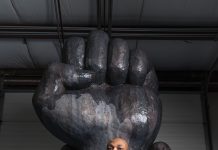
What am I looking at?
Just what it looks like — a milkshake piled high with cake, ice cream, and more. But it’s also a still image taken from a 3D rendering created using 300 high-res images of the Supreme Strawberry Rare Token from Garrido’s Bistro in Grosse Pointe Woods. Garrido’s sold a similar shake as an NFT on April 1 for .25 Ethers. That equaled $497 that day, and it hit a value of $1,044.95 in late May. Co-owner Vanessa Gonzalez says the NFT cost thousands in equipment to make.
A what?
NFT stands for “non-fungible token,” a bit of jargon that just means that something is a one-of-a-kind digital item (“non-fungible”) represented by a piece of blockchain technology (“token”). Think of it this way: The “Mona Lisa” is non-fungible, whereas the breakroom’s “Hang in There” poster of a dangling kitten is as fungible as it gets. The token is how you prove your “Mona Lisa” is the original, not a copy.
Right, right. Uhh, what’s blockchain?
This is the really complicated part, and if you don’t get it, you’re definitely not a dummy, but you’ll just have to trust us that it’s a really important way of keeping track of ownership of virtual possessions and the exchange of money. Blockchain is a system of shared digital ledgers. When a new transaction is created, it contains a code (called a “hash”) that includes all previous blocks in the chain to prove its unique origin and chain of ownership. Because all of this code is specific and unique to the transaction in question, it is impossible to create a fraudulent transaction — making it the most secure means of exchange online. If you own an NFT, that unique code is a rock-solid receipt of ownership.

OK. So, what’s this got to do with that milkshake?
The Supreme Strawberry is an original piece of digital art embedded with unique code that only the person who buys it has. Buyers get bragging and property rights. The copyright or trademark can stay with the creator, and the artists may get royalties on re-sales. Garrido’s has “minted” 100 of this milkshake NFT for sale on the blockchain, so they probably won’t sell for as much as their first foray.
But it’s also a real milkshake?
Well, it was, but it melted long ago. Making NFTs of the shakes was a publicity stunt — hey, look, it worked! — for an eatery known for such wacky desserts and hard-hit by pandemic restrictions. It’s also worked for Pizza Hut Canada, which sold an NFT of a pizza for nearly $9,000. Garrido’s is exploring ways to make buying NFTs the equal of prepaying for a real-world milkshake to drive diners to the restaurant, Gonzalez says.
Why pay so much money when you can copy an image yourself?
Because some people want the original. It’s the difference between owning a mint condition 1954 Al Kaline Tigers baseball rookie card worth $192,000 or getting the copy of a reprint for $2.83 on eBay.
Are NFTs a fad? Or, like Twitter circa 2010, must I really get what you’re going on about?
That’s your call, but many people believe NFTs will revolutionize the art world. NFTs are springing up in many forms, from X-rays of William Shatner’s teeth to a column from The New York Times. The website Crypto Art reported nearly $200 million of NFTs sold in March, an impressive surge given that the total sale of NFTs since 2018 was $679 million at that point. Ignore this trend at your own risk.
|
|
|









